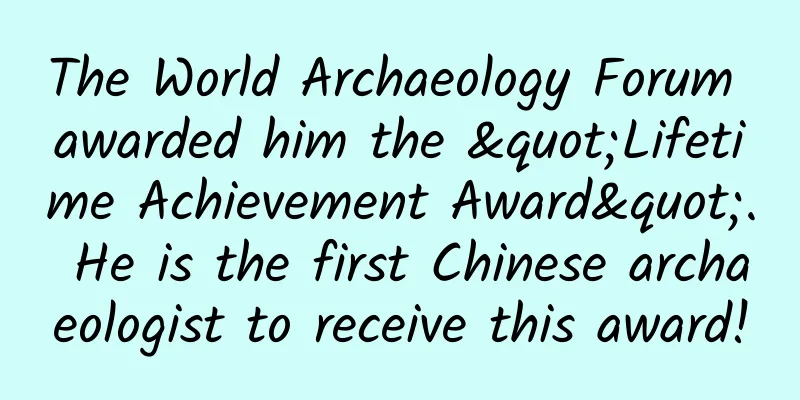The World Archaeology Forum awarded him the "Lifetime Achievement Award". He is the first Chinese archaeologist to receive this award!

|
Recently, another major event happened in the world archaeology community! The Fifth World Archaeology Forum awarded the "Lifetime Achievement Award" to Professor Yan Wenming of Peking University. Recent photo of Professor Yan Wenming As the highest honor awarded by the World Archaeology Forum, the Lifetime Achievement Award is specifically given to scholars who are renowned worldwide, have profound academic attainments, and have a wide and far-reaching influence on the field of archaeology. In previous sessions, this award was given to Lord Colin Renfrew, Professor Brian Fagan, and Academician Jane Brown. This is the first time that the forum has awarded this award to a Chinese archaeologist. Award Speech From physics to archaeology Yan Wenming was born in Hunan in 1932. His name was taken by his father from the "Junzhe Wenming" in the "Book of Documents: Shun Dian", which carries the hope of "wisdom and excellence". With the good wishes and hopes of his family, Yan Wenming lived up to expectations since he was a child and his academic performance was always among the best. In 1953, Yan Wenming graduated from Changsha No. 1 Middle School and chose the Department of Physics at Peking University as his first choice in the college entrance examination, but by accident he ended up entering the History Department. At that time, the History Department of Peking University had three majors: Chinese History, World History and Archaeology. Students were divided into different majors in their second year of university. Su Bingqi, then director of the Archaeology Teaching and Research Section of Peking University, heard that Yan Wenming had good grades in science and encouraged him to choose archaeology, but Yan Wenming said frankly that he knew nothing about archaeology. Hearing Yan Wenming's answer, Su Bingqi smiled and said to him: "That's perfect, you study archaeology. Although archaeology is also in the History Department, the knowledge and research methods it requires are very different from history. For example, archaeology requires measurement and statistics, and knowledge of mathematics and physics are also needed in archaeology." With curiosity about research in this field, Yan Wenming was led into the door of archaeology by Su Bingqi. As the saying goes, a master can only lead you to the door, but the practice is up to you. The deeper Yan Wenming gets into it, the more he can feel the mystery of archaeological research. Archaeology is taught in the field. In his senior year, Yan Wenming participated in archaeological internships at the Jiangou and Guitai sites in Handan. From investigation and excavation to sorting and writing reports, his love for archaeology became stronger after one semester. In the process of deepening his research and study, Yan Wenming's talent in the field of archaeology was gradually noticed by his "guide" Su Bingqi. When he graduated from his senior year, Su Bingqi assigned Yan Wenming a new task: to stay in school and teach. At that time, Peking University had teachers for Paleolithic archaeology and Shang and Zhou dynasty archaeology, but no teacher for Neolithic archaeology. Yan Wenming's job was to fill this gap and specialize in Neolithic archaeology. Without any teaching experience, Yan Wenming went to many cultural relics research institutes across the country to look at the things in their warehouses and take notes. He hoped that the courses he taught would not only fill the teaching gaps in the school, but also that he could study the theories and methods of Neolithic archaeology and play a role in the entire field of archaeology. Since he officially taught the "Neolithic Archaeology" course in the fall of 1961, Yan Wenming has been standing on the podium for more than half a century. The "China Neolithic Age" (first draft of the lecture notes) he compiled was the first textbook of archaeology at Peking University. It was later used by archaeology majors in major universities and made outstanding contributions to archaeological teaching in my country. China's Neolithic Age (Draft of Lecture Notes) From Yangshao to Liangzhu When engaging in archaeological research, Yan Wenming always advocates not limiting knowledge to book knowledge, but conducting practical investigations based in the field. In the archaeological community, there has always been an unsolved mystery about the Yangshao culture, which began in the 1920s. At that time, Swedish scholar Andersson discovered the Yangshao site in China, and since then, research on the Yangshao culture has attracted much attention from scholars at home and abroad. After the founding of New China, debates about the Yangshao culture have continued, and the classification and origin of the Yangshao culture have always been a mystery in the archaeological community. Yangshao Village Ruins (Photo by Gu Yanmin) In order to solve this mystery, Yan Wenming led the team on a long journey of exploration. In 1960, Yan Wenming led his students to Wangwan, Luoyang for the first time for archaeological practice. He instructed his students to use the Wangwan site, which has clear stratigraphic layers and detailed periodization, as a benchmark to measure the periodization of the nearby Yangshao site. Later, by re-sorting the materials of the Yangshao Village, Xiyin Village, Miaodigou, Sanliqiao, Banpo and other sites, he clarified the development trajectory of the Yangshao culture from the Banpo type to the Miaodigou type, and divided the overall development of the Yangshao culture into "two phases and four sections", laying the foundation for the study of the Yangshao culture. This research was later evaluated by Su Bingqi as "finding a key to open the entire study of the Neolithic culture in China." "Taihu civilization has a history of 5,000 years, and Songze and Liangzhu are connected. They opened up thousands of miles of fertile land and pioneered the use of stone plows to cultivate rice fields." In the process of Chinese civilization, Liangzhu culture occupies a very important position. Over the years, Yan Wenming has led his team to study and investigate the Liangzhu ruins more than ten times, and was hired as a member of the Liangzhu ruins protection expert group. For this purpose, he wrote this "Liangzhu Ode", which is widely circulated in the archaeological circle. After that, his judgment that "the central area of the Liangzhu site should also be a city site" or "the Mojiaoshan site is a terraced city" first proposed in his works became the forerunner of the discovery of the Liangzhu ancient city. In 2007, a Liangzhu ancient city of about 3 million square meters finally appeared before the world. Yan Wenming believes that the discovery of the Liangzhu ancient city plays a finishing touch to the entire archaeological work of the Liangzhu site. "It changed the original perception that the Liangzhu culture was just a glimmer of civilization, and it marked that the Liangzhu culture had actually entered a mature prehistoric civilization development stage." During his decades of archaeological career, Yan Wenming has presided over more than 20 important field archaeological excavations or surveys, and his footprints have spread all over the country. It is this accumulation of experience in the field that has enabled him to be academically forward-looking. Under his promotion, the Department of Archaeology at Peking University was formally established as the first archaeology department in the country, which is of milestone significance to the construction of my country's archaeological discipline and the training of archaeological talents. Yan Wenming's acceptance speech When he learned that he had won the "Lifetime Achievement Award" at the Fifth World Archaeology Forum, the 91-year-old Yan Wenming was very calm. He said: "Thank you for giving me such a high honor. I am just working hard and don't care about the harvest." |
<<: Can a spacecraft be blown away with just one breath?
Recommend
In 2025, ZeroBeam Full Stack 3.0 will be fully implemented to support L3 autonomous driving
(May 24, 2024, Shanghai) At the "SAIC New En...
How does Starbucks build a membership growth system?
In the morning, I took the curriculum development...
2019 Internet Marketing Promotion Tips!
With the gradual improvement of current Internet ...
How can programmers quickly get promoted and get a raise at the beginning of their careers?
In a mature medium or large organization, profess...
With five all-round reciprocating blades, this Mijia electric shaver makes shaving a breeze
There are many essential items in a man's lif...
What is a polygenic risk score? Will “scientific fortune-telling” be possible in the future?
Although it is already 2022, it is still a common...
Why are the lakes in scenic spots green? Is it the reflection of the trees? Actually, it’s thanks to this!
The guest road is beyond the green mountains, and...
What are the functions of the outbound travel mini program? How much does it cost to make an entry and exit mini program?
With the continuous development of China's ec...
Learn 3 types of word-of-mouth marketing strategies from the word-of-mouth case of Dong-E E-Jiao
In the Internet era, a number of new brands conti...
What? The "top-tier" giant panda can actually bark like a dog? 7 little-known facts about giant pandas
Speaking of our national treasure The first thing...
Google's app privacy policy confuses even Google itself
This article is reproduced from Leiphone.com. If ...
Meizu Blue challenges Redmi: Is there still a chance in the thousand-yuan phone market?
There have been rumors that Meizu will launch a t...
A collection of features of 17 mainstream online marketing and promotion channels!
We have sorted out 17 mainstream online marketing...
How to establish long-term relationship chains with users?
This article will explore the tricks to attract u...
Chris Ke Lisi "Advanced Technology Pro" Baidu network disk download
Chris Ke Lisi's advanced technology Pro tutor...









